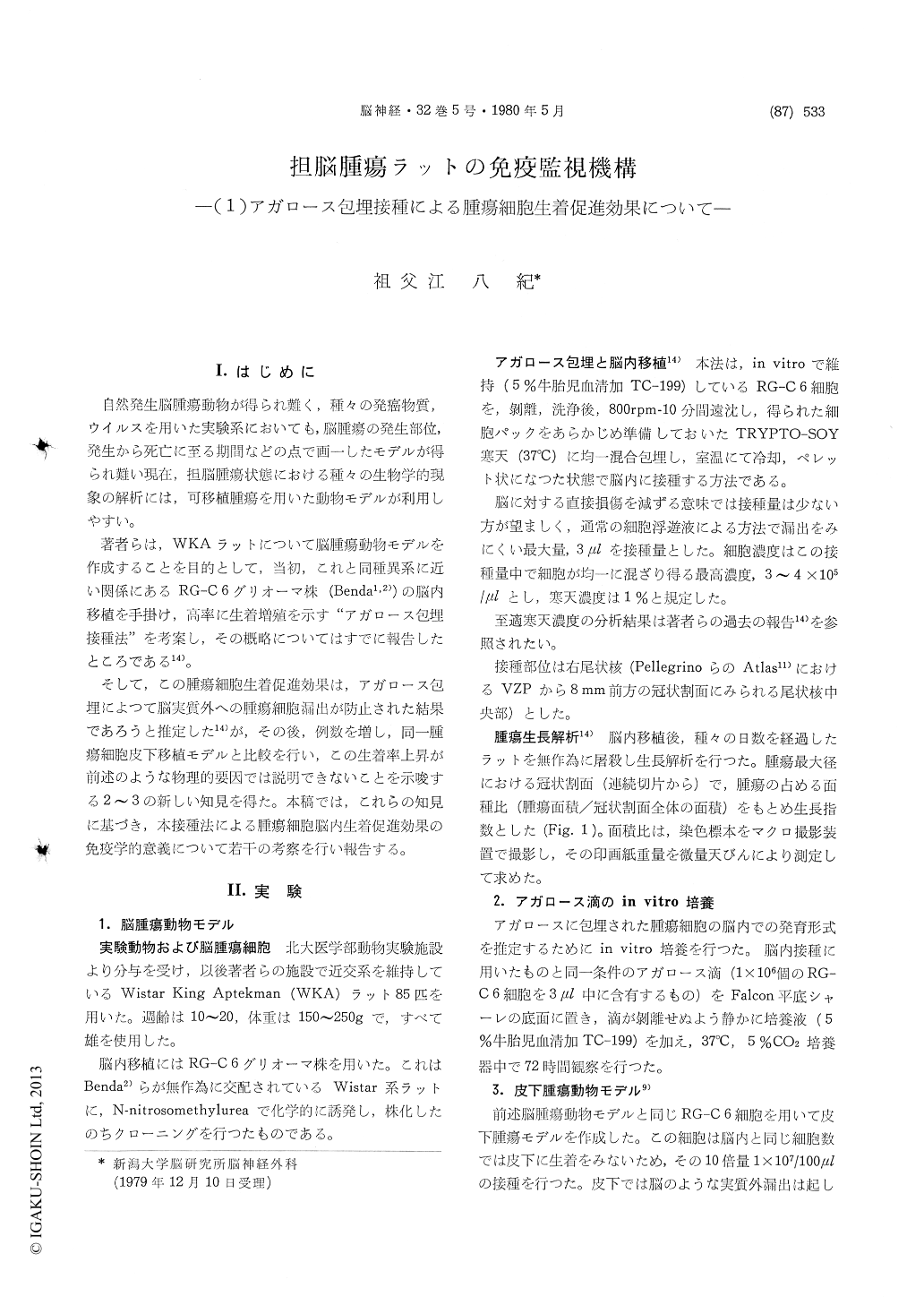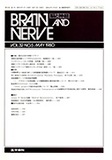Japanese
English
- 有料閲覧
- Abstract 文献概要
- 1ページ目 Look Inside
I.はじめに
自然発生脳腫瘍動物が得られ難く,種々の発癌物質,ウイルスを用いた実験系においても,脳腫瘍の発生部位,発生から死亡に至る期間などの点で画一したモデルが得られ難い現在,担脳腫瘍状態における種々の生物学的現象の解析には,可移植腫瘍を用いた動物モデルが利用しやすい。
著者らは,WKAラットについて脳腫瘍動物モデルを作成することを目的として,当初,これと同種異系に近い関係にあるRG-C6グリオーマ株(Benda1,2))の脳内移植を手掛け,高率に生着増殖を示す"アガロース包埋接種法"を考案し,その概略についてはすでに報告したところである14)。
Intracerebrally inoculated tumor cell suspention was liable to overflow from the cerebral parenchyma because of its counter pressure. And we originally thought that it was a major cause for the low incidence of tumor take and the unevenness of tumor growth. Then we designed a new method of"Soft Agar Technique"for the aculate trans-plantation of RG-C6 glioma cells into the brain of allogeneic WKA rats, and prepared a brain tumor model.
Centrifugated tumor cell pack was mixed quickly and uniformly with agarose sol kept at 37℃. The TRYPTO-SOY AGAR, commonly used for the culture and separation of bacterias, was better for the maintenance of viability of the tumor cells. This agarose sol easily changed into gel in room temperature and we inoculated the gel with tumor cells into the brain. We made it a role to inocu-late 3 ul of volume for the prevention of brain damage. The optimum concentration of agarose for the maintenance of sol at 37℃ was 1.0%. The optimum number of tumor cells to get a uniform mixture in the agarose sol, was 1×106/3 ul. And in this condition we could get 89.7% of incidence. Inoculating 1×106/3 ul of tumor cells in the usual form of cell suspention, the incidence was only 35.5%.
We killed the rats at random days post-implant, and analysed the tumor growth. The growth index was calculated by weighing and comparing the percentage of tumor area to the figure of the entire coronal section. Generally the tumor growth curve was represented in a straight regression line,with statistical significance. Investigating the tumor growth in the period from the 20th to the 30th day after transplantation, the gradient of the growth curve tended to become steep. The brain tumor had a diameter of about 8 milimeters on and after the 30th day post-implant.
Subcutaneously inoculating 1×106 of tumor cells in the form of cell suspension, they were rejected promptly and there was no tumor growth. In order to get 100% of tumor take, it was necessary to inoculate 10 times that number into the brain. The growth index was taken by multiplying the major to minor axis of the tumor. The tumors increased in size in about 8 days post-implant, and then regressed. They dissapeared on the 17th day post-implant. The subcutaneous tumor, at the stage of maximum growth, had a diameter of more than 8 milimeters.
As compared with the subcutaneous tumor growth, brain tumors grew more slowly. And gathering from the cell cycle time of RG-C6 IN VITRO, we could not attribute this finding to the difference of innoculated tumor cell numbers be-tween the both. In order to get a solution to this problem, we cultured the agarose droplets with 1×106 of tumor cells in TC-199 medium. Then, tumor cells began to spread out from the surface of droplets in the process of time and increased in number up to 48 hours after cultivation. However most cells in the droplets remained out of the tumor growth.
If this condition might happen also IN VIVO, it was surmized that the small numbers of tumor cells rather originated the high incidence of tumor take, contrary to our original expectation. Refer-ring to this attractive results, we must give our mind to the existance of "Dilution Escape Phenomenon"in the brain. And in this condition, intracerebrally inoculated tumor cell growth may well have been retarded.

Copyright © 1980, Igaku-Shoin Ltd. All rights reserved.


